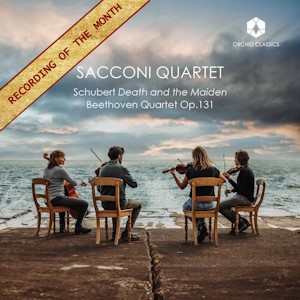
Franz Schubert (1797-1828)
String Quartet No 14 in D minor D. 810, Death and the Maiden (1824)
Ludwig van Beethoven (1770-1827)
String Quartet No 14 in C-sharp minor, Op 131 (1826)
Sacconi Quartet
rec. 2022, Wyastone Recording Studio, Wyastone Leys, UK
Orchid Classics ORC100265 [80]
The recording of these two great, almost exactly contemporaneous string quartets of the same number was the Sacconi Quartet’s 21st birthday present to themselves as music which meant the most to them and the quartets which arguably represent for each composer “the summation of his art”, as Duncan Eves’ brief but helpful note puts it. As it turns out, this recording is a present to listeners, too (even if – quite rightly – they will need to part with a little cash to enjoy it).
I guess it helps to be found in a reflective state of mind before embarking upon listening to such sombre music; both were written by composers undergoing severe trials in their personal lives – not that such circumstances are invariably reflected in compositions, as some of Mozart’s works bear witness – but there is no doubt that these quartets were conceived under the shadow of mortality and sadness.
Last year when reviewing the Melos Quartet’s account of the Death and the Maiden, I praised it while still preferring overall the Amadeus and Chilingirian Quartets’ versions and I have long prized the Medici Quartet in the Beethoven; those last two are on the Nimbus label. The complete set of the Beethoven works by the Alban Berg Quartet is also highly recommendable. I have also more recently endorsed excellent sets of the Late Quartets by the Dover and Calidore Quartets – particularly the way of both ensembles with the sublime opening Adagio of No 14 – but the combination here of the two famous quartets on one disc played by a foremost British ensemble has its obvious attractions.
I am immediately drawn to the Sacconi’s challenging style by the way they attack those first harsh, fortissimo D chords then tear into the triplet motif; the acoustic, too, is just right; credit to engineer Dave Rowell for giving it the right space and resonance, not too close and suitably jarring for this violent, disturbing music. There is light and shade, plenty of dynamic variation and subtle rubato applied to the second theme underpinned by rippling semiquavers without the tension ever slackening. It is very clear that the quartet has put much thought into how individual lines should be played; I take, as a random but typical example, the cello’s prominent contribution from 7:53 onwards to 8:20; it is like the bass in an operatic quartet stepping forward front stage to deliver a warning – and again 9:40, its vehemence is almost frightening. The variations of the second movement are played with a keening intensity alternating with floating lyricism and the purity of tone from Ben Hancox’ first violin is captivating; however, there is no sense of showboating, rather always a pervasive sense of homogeneity in the ensemble and the spotlight passes easily from one instrument to another, especially as the sound balance among them is so good. Thus, the bass growling of the cello in the fifth and final variation comes through strongly without overpowering the arpeggiated motif.
The lilting trio interposed in the frenetic Scherzo comes as a welcome – but very short-lived – relief and the torque is soon re-applied in the frantic “Dance of Death” Presto, immaculately played here – not so fast as to blur the divisions but still compelling. Both violinists are on fire and the movement builds to a thrilling climax.
Some respite is required before moving straight on to what Beethoven considered to be his greatest quartet – not his favourite; that was Op 130 – and in my case, that pause was taken up by some mundane household chores, as one cannot just plunge into Op 131 after such Schubertian turmoil.
Minimal vibrato and “a dying fall” in the phrasing grace the melancholy fugal opening, which is executed just as I like to hear it done; there is an ineffable, soul-tearing sweetness and profundity to this music which is fully realised by the Sacconi quartet here. As with the Cavatina of Op 130 and the “”Heiliger Dankgesang” in No 15, time seems to stand still and the contrast with the immediately ensuing Allegro molto vivace is almost comical, such is the insouciance of that music, played here with a deft and light touch; the sense of two sides of the same coin – human existence – is acute. As the notes suggest, that same bipartite unity applies to the relationship between the next two movements – the tiny Allegro moderato and the Andante…molto cantabile – in effect, in combination with the same principle being applied to the last two movements, leaving the fifth movement Presto to function as a Scherzo and reducing what appears to be seven movements to the classic four-movement form. Certainly there is an overriding sense of unity to the Sacconi’s delivery – at least, as great a feeling of integrity as can be applied to a work at whose centre lies the capricious, even mischievous, whimsy of Beethoven’s “Grand Variations” spanning a bewildering multitude of moods all crammed into a mere quarter of an hour. They also capture the sense of fun which pervades the dashing Presto, reminding us that this is by no means as funereal a work as Schubert’s; there is no holding back on the sheer, puckish glee of those pizzicato interjections!
The stately beauty of the second Adagio is elegantly delivered before the thrust and turmoil of the bouncing of the main theme in the final movement. Such is the expertise and excellence of these performances that on first listening, I frequently returned to hear key passages again; I cannot imagine anyone being other than enraptured by them.
Ralph Moore
Help us financially by purchasing from




















